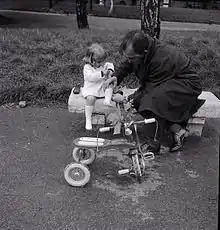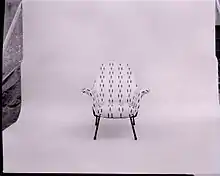Marco Zanuso
Marco Zanuso (14 May 1916 – 11 July 2001) was an Italian architect and designer.


Early life
_-_BEIC_6355518.jpg.webp)

Marco Zanuso was born in Milano (Italy) 14 May 1916. He was one of a group of Italian designers from Milan shaping the international idea of "good design" in the postwar years. Trained in architecture at the Politecnico di Milano university, he opened his own design office in 1945. From the beginning of his career, at Domus where he served as the editor from 1947–49 and at Casabella where he was editor from 1952–56, he helped to establish the theories and ideals of the energetic Modern Design movement. As a professor of architecture, design and town planning at the Politecnico from the late 1940s until the 1980s, and as one of the founding members of the ADI in the 1950s, he also had a distinct influence over the next design generation coming out of Italy.
Career
In 1957 Zanuso partnered with German designer Richard Sapper. One of their first projects was a small, stackable child's chair (1961) in non-reinforced plastic. This piece was light, functional and playful, manufactured in several bright colors and it was among the furniture designs responsible for convincing people that plastic was a viable and appropriate material for the modern home. Zanuso and Sapper were hired in 1959 as consultants to Brionvega, an Italian company trying to produce stylish electronics that would, at least outwardly, best those being made in Japan and Germany. They designed a series of radios and televisions that became enduring icons of an aesthetic known as "techno-functionalism". Their rounded, compact and portable "Doney 14" (1962) was the first completely transistor television. Working with the language of sculptural minimalism they designed the successful folding "Grillo" telephone for Siemens (1966). This was one of the first phones to put the dial and the earpiece on the same unit.
In a 1972 they designed a series of dwellings for the "New Domestic Landscape" show at the MoMA. Each stacking unit, like ultramodern teepees, unfolded to a living area complete with all the facilities and many of the accessories of a small apartment. Zanuso wrote that they were "designed for all situations that require immediately available, easily transportable living quarters." As with the rest of their work, the hallmarks of these designs were elegance and imagination.
Works
The major pieces of his career run a broad spectrum from early experiments in bent metal to luxurious, plush furniture to sleek industrial designs in plastic. The underlying motif throughout each phase of his work is that he was pioneering the use and market accessibility of every different material he worked with. Some of his first work to be shown at all, and certainly to be shown outside of Italy, was at the Low-Cost Furniture competition sponsored by the MoMA in 1948. His design featured a metal frame chair that used a breakthrough method to join the fabric seat to the frame. In 1948 Pirelli opened a new division, Arflex, to design seating with foam rubber upholstery. They commissioned Zanuso to produce their first models. His "Antropus" chair came out in 1949, followed by the "Lady" chair, which won first prize at the 1951 Milan Triennale. Zanuso lauded the new material, "One could revolutionize not only the system of upholstery but also the structural manufacturing and formal potential...our prototypes acquired visually exciting and new contours...with industrial standards that were previously unimaginable."
Different items of his work in the collections of the Museum of Modern Art in New York City, Triennale Milano, Triennale Tokyo, Vitra Museum, Arflex Museum and Kartell Museum.
Significant products
- 1951 armchair "Lady" for arflex (Medaglia d'Oro Triennale)
- 1952 armchair "Martingala" for arflex
- 1952 sofa "Tripoltrona" for arflex (Medaglia d'Oro Triennale)
- 1954 sofa "Sleep-o-matic" for arflex (Medaglia d'Oro Triennale)
- 1955 Olivetti buildings in Buenos Aires and San Paolo
- 1960 chair "Lambda" with Richard Sapper for Gavina
- 1962 television "Doney" with Richard Sapper for Brionvega
- 1963 car with Richard Sapper for Alfa Romeo
- 1964 television "Algol" with Richard Sapper for Brionvega
- 1964 armchair "Woodline" and "Fourline" for arflex
- 1964 child's chair K4999 with Richard Sapper for Kartell
- 1965 Radio TS 502 with Richard Sapper for Brionvega
- 1966 telephone "Grillo" with Richard Sapper for Siemens
- 1969 television "Black" with Richard Sapper for Brionvega
- 1970 table "Marcuso" for Zanotta
- 1970 pen "Hastil[1]" with Richard Sapper for Aurora
- 1974 IBM building in Milano
- 1998 New theatre Piccolo teatro in Milano
- Photo by Paolo Monti
_-_BEIC_6355467.jpg.webp) Cedit shop, Milan, 1957
Cedit shop, Milan, 1957_-_BEIC_6355455.jpg.webp) Shop installment, 1957
Shop installment, 1957 CEDIS ceramics industry, Palermo
CEDIS ceramics industry, Palermo_-_BEIC_6355783.jpg.webp) Exhibition about aviation pioneers, Royal Palace of Milan, 1960
Exhibition about aviation pioneers, Royal Palace of Milan, 1960
External links
Notes
- François Burkhardt, Marco Zanuso. Design, Federico Motta Editore, 1994, ISBN 88-7179-082-0
- Aldo Colonnetti Grafica e Design a Milan 1933–2000, Editore Collana AIM – Abitare Segesta Cataloghi, Milan 2001.
References
- "Aurora Hastil Fountain Pen". Unsharpen.com. Unsharpen.com. Retrieved 28 March 2020.